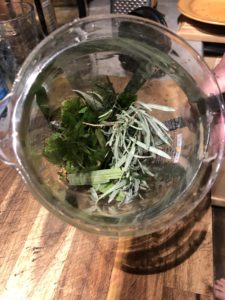Seed Saving Blog

Evening Elixirs of Joy: Grow Your Own Herbal “Tea”
Written by Belle Starr
Every eveni ng after we settle in for the night’s activities my husband Bill McDorman puts on a pot of water and goes out to the garden to harvest his latest soothing elixir of goodness. This is a ritual I have been part of for almost two decades and I always take it for granted that there will be some delicious mix of herbs and other interesting leaves and twigs to round out yet another busy day.
ng after we settle in for the night’s activities my husband Bill McDorman puts on a pot of water and goes out to the garden to harvest his latest soothing elixir of goodness. This is a ritual I have been part of for almost two decades and I always take it for granted that there will be some delicious mix of herbs and other interesting leaves and twigs to round out yet another busy day.
Unbeknownst to me until recently, I learned there is actually a name for what Bill does. It is called tisane (tea – zahn) and he engages in this process regularly. Tisanes are infusions of leaves and various other garden delights, but technically are not considered teas. “Tea” is a specific variety of plant (Camellia sinensis.) Teas are created from leaves of white, green, black, and oolong tea shrubs.
Bill’s cornucopia of choices includes mint (always in production around here), lavender, lemon grass, Mexican sage, rosemary, lemon balm and oregano. While one would suspect that some of these herbs may overwhelm the taste buds, in just the right amounts they play well together and taste delicious! I can’t say that Bill combines all the aforementioned herbs every time, but mixes and matches as he desires.

The good news is that all these herbs are great for us and have so many beneficial characteristics. Not only can they taste divine when used in the right amounts, their essential oils and constituents serve our bodies in so many ways.
- Lavender is known for its calmative properties, its antifungal ability and support of digestive issues.
- Sage is antiseptic, antibacterial and is used for various kinds of inflammation.
- Oregano is an antioxidant, and like sage, is antibacterial.
- Mint of course is great for indigestion and helpful for respiratory function. It also makes breath smell fresh.
 A typical evening libation might be a small handful of mint, a few leaves of lavender and a small sprig of rosemary. Bill pours slightly cooled boiling water over the leaves in a tea diffuser and lets it steep longer than a traditional tea (4 minutes). The longer the steep, the more flavor and more release of the essential oils and constituents. There is always immediate feedback of smell and flavor, and every evening another trial tisane is served.
A typical evening libation might be a small handful of mint, a few leaves of lavender and a small sprig of rosemary. Bill pours slightly cooled boiling water over the leaves in a tea diffuser and lets it steep longer than a traditional tea (4 minutes). The longer the steep, the more flavor and more release of the essential oils and constituents. There is always immediate feedback of smell and flavor, and every evening another trial tisane is served.
One of the added benefits of having the remnants of a pot full of tisane greet us in the morning is what we call the morning rinse. It is always so delightful to drink up last night’s mix as a precursor to indulging in delicious coffee. And it is so good for our digestive systems.
 Of course, herbs in the garden are a welcome component to any diverse and ecologically healthy landscape. They act as natural insect repellents and attract all kinds of beneficial insects (butterflies, insects, birds, etc.)
Of course, herbs in the garden are a welcome component to any diverse and ecologically healthy landscape. They act as natural insect repellents and attract all kinds of beneficial insects (butterflies, insects, birds, etc.)
Oh, and did we mention, that most are delicious in an array of various dishes? Cooking with homegrown fresh herbs isn’t just for gourmet chefs. Learn what you need to know about growing and preserving herbs for culinary and medicinal purposes here: Growing Culinary Herbs by Kari Spencer.
****Join us this Tuesday at 6 pm (Mountain Time, 5 pm Pacific) for Seed Chat when Bill McDorman and Greg Peterson discuss Culinary and Aromatic Herbs.
Those who join in will received a free electronic copy of the booklet, Eat, Drink and Be Merry: Herbs That Please Our Palettes and Keep Us Healthy
Recent Posts
- 2023 SEED LIST – Phoenix Seed Up Event October 27-28
- Seed Resources: Navigating the Abundance of Knowledge
- Seed List for the Phoenix Seed Up Event November 4-5, 2022
- Your Personal Seed Bank: Doomsday Vault or Your Best Shot at an Abundant Future?
- What is the Great American Seed Up??
- HOME GARDENERS FACE SEED SHORTAGES
- What In the World is Happening with Grain?
- Grains in Gardens & Other Skills to Learn & Share
